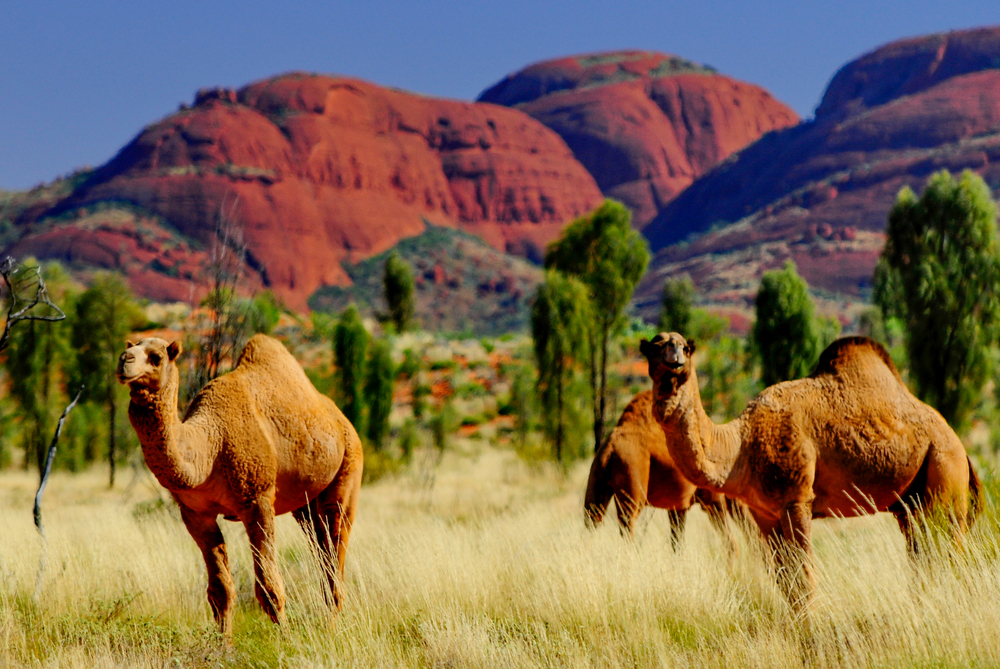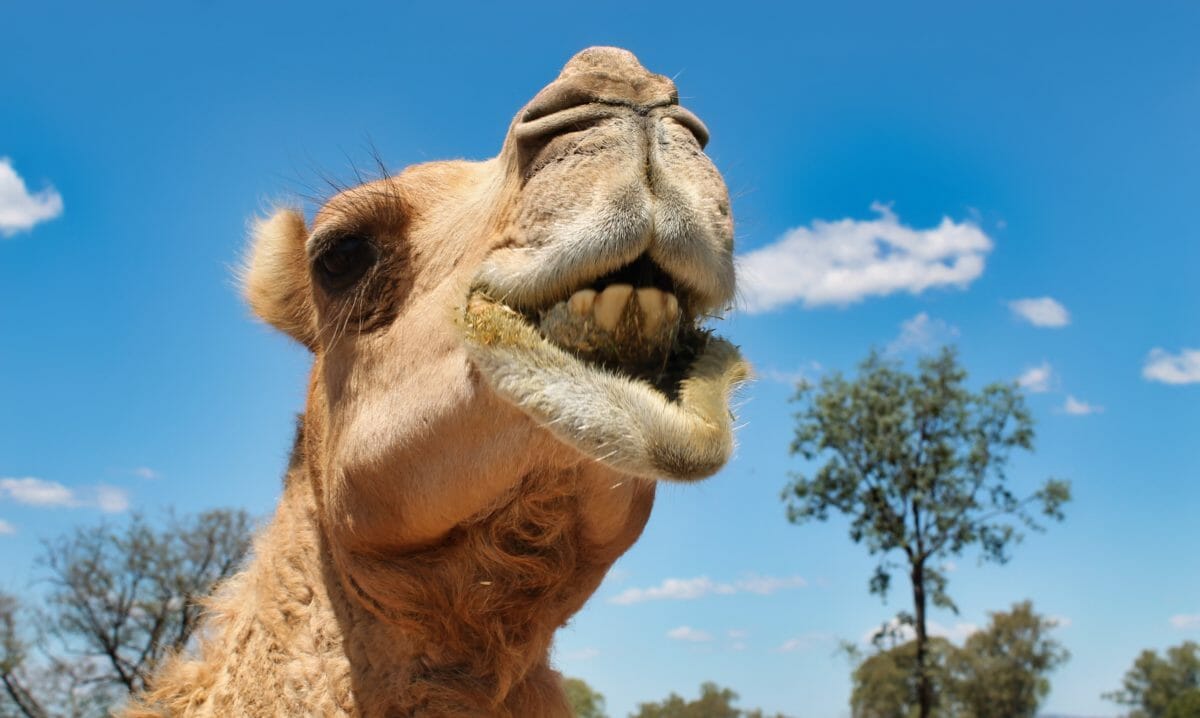A Dairy Solution for Australia’s Out-of-Control Feral Camels
Australia has the biggest feral camel population in the world, but one farmer is working to change public perception of this ‘pest’.
A Dairy Solution for Australia’s Out-of-Control Feral Camels
Australia has the biggest feral camel population in the world, but one farmer is working to change public perception of this ‘pest’.

Feral camels have thrived in Australia. by Stanislav Fosenbauer on Shutterstock
Ten years ago, Australian cattle grazier Paul Martin decided that he couldn’t stand to see another camel shot.
In the 1800s, camels were shipped to Australia from the Middle East, India and Afghanistan to help open up the country’s vast remote interior. They were later released into the Australian wilderness en masse with the advent of mechanised transportation.
With their energy-storing humps, broad toes that support their weight on sand and ability to eat 85 percent of even tough and thorny vegetation, they were perfectly suited to the dry, desert conditions which make up more than one-third of the continent.
Yet with a feral population numbering more than a million, and doubling every eight to 10 years, according to the federal government’s National Feral Camel Action Plan, they have wreaked havoc on landscapes and infrastructure. As a result, farmers have killed hundreds of the animals every day in an officially-sanctioned cull, which struck Martin as short-sighted and wasteful.
“My frustration was that people who have these problems with camels can’t see the opportunity,” he says.
In 2015, Martin and his then business partner, biochemist Jeff Flood, convinced some landowners to stop shooting the dromedaries and, instead, help round them up. They transported 20 camels to a rural property on the outskirts of Ipswich, one of Queensland’s oldest cities, to see if they could turn them into milking camels.
To set up his operation, Martin had to oversee a complicated retrofitting of standard dairy equipment. While cows and camels both have four teats, the similarities end there. Camels are, obviously, much taller. A milking mother must be calm, and have her calf nearby, in order to experience the oxytocin rush which triggers the flow of milk. Even when all these conditions are favorable, a lactating camel will yield only 2.5 liters (less than a gallon) of milk per day on average, as compared with a cow’s 40-55 liters (10.5-14.5 gallons).

In 2016, the original herd, and an additional 40 captured camels, moved to its current location, an 830-acre property at nearby Harrisville, where Martin’s camel dairy, Summer Land Camels, is still based. His herd grew as he bred camels and flew in more captured animals by helicopter from far-flung locations in Australia. Summer Land Camels now has 550 camels on site and produces more than 1,000 liters (264 gallons) of milk a week.
The cost of producing and purchasing camel milk is fairly steep. Summer Land Camels currently sells a liter of milk (or about a quarter of a gallon) for eighteen Australian dollars. Yet the health properties attributed to camel milk means people are increasingly willing to pay.
Nidhi Bansal, a senior lecturer in food science at The University of Queensland, has been studying camel milk for five years. She says it contains three to five times more vitamin C than cow’s milk, but has no beta-lactoglobulin, a whey protein in cow and sheep’s milk.
“Camel milk has high antimicrobial activity due to the abundance of protective proteins in it, such as lactoferrin and immunoglobulins,” Bansal adds.
Summer Land Camels produces camel milk gelato, cheese and even vodka, courtesy of the whey left over from cheese-making. The farm also produces about 500 kilograms (1,102 pounds) of camel meat a week, using a specialty slaughterhouse.
Tourism wasn’t part of Martin’s original plan, but the interest shown by curious visitors (and the occasional selfie-seeking fence-jumper) encouraged him to introduce farm tours and camel rides.
Martin says his operation has adopted animals that would otherwise be discarded as a nuisance for farmers, and turned them into an economic opportunity. He hopes that the camel dairy industry will expand beyond the current handful of operators that exist in Australia—and not just for the sake of farmers, but for the camels, too.
“If we go and shoot them out, we’re never going to get them back again,” he says. “We’re trying to save these animals by turning (them) into something that people will farm and enjoy.”
Follow us

This work is licensed under a Creative Commons Attribution-NoDerivatives 4.0 International License.
Want to republish a Modern Farmer story?
We are happy for Modern Farmer stories to be shared, and encourage you to republish our articles for your audience. When doing so, we ask that you follow these guidelines:
Please credit us and our writers
For the author byline, please use “Author Name, Modern Farmer.” At the top of our stories, if on the web, please include this text and link: “This story was originally published by Modern Farmer.”
Please make sure to include a link back to either our home page or the article URL.
At the bottom of the story, please include the following text:
“Modern Farmer is a nonprofit initiative dedicated to raising awareness and catalyzing action at the intersection of food, agriculture, and society. Read more at <link>Modern Farmer</link>.”
Use our widget
We’d like to be able to track our stories, so we ask that if you republish our content, you do so using our widget (located on the left hand side of the article). The HTML code has a built-in tracker that tells us the data and domain where the story was published, as well as view counts.
Check the image requirements
It’s your responsibility to confirm you're licensed to republish images in our articles. Some images, such as those from commercial providers, don't allow their images to be republished without permission or payment. Copyright terms are generally listed in the image caption and attribution. You are welcome to omit our images or substitute with your own. Charts and interactive graphics follow the same rules.
Don’t change too much. Or, ask us first.
Articles must be republished in their entirety. It’s okay to change references to time (“today” to “yesterday”) or location (“Iowa City, IA” to “here”). But please keep everything else the same.
If you feel strongly that a more material edit needs to be made, get in touch with us at [email protected]. We’re happy to discuss it with the original author, but we must have prior approval for changes before publication.
Special cases
Extracts. You may run the first few lines or paragraphs of the article and then say: “Read the full article at Modern Farmer” with a link back to the original article.
Quotes. You may quote authors provided you include a link back to the article URL.
Translations. These require writer approval. To inquire about translation of a Modern Farmer article, contact us at [email protected]
Signed consent / copyright release forms. These are not required, provided you are following these guidelines.
Print. Articles can be republished in print under these same rules, with the exception that you do not need to include the links.
Tag us
When sharing the story on social media, please tag us using the following: - Twitter (@ModFarm) - Facebook (@ModernFarmerMedia) - Instagram (@modfarm)
Use our content respectfully
Modern Farmer is a nonprofit and as such we share our content for free and in good faith in order to reach new audiences. Respectfully,
No selling ads against our stories. It’s okay to put our stories on pages with ads.
Don’t republish our material wholesale, or automatically; you need to select stories to be republished individually.
You have no rights to sell, license, syndicate, or otherwise represent yourself as the authorized owner of our material to any third parties. This means that you cannot actively publish or submit our work for syndication to third party platforms or apps like Apple News or Google News. We understand that publishers cannot fully control when certain third parties automatically summarize or crawl content from publishers’ own sites.
Keep in touch
We want to hear from you if you love Modern Farmer content, have a collaboration idea, or anything else to share. As a nonprofit outlet, we work in service of our community and are always open to comments, feedback, and ideas. Contact us at [email protected].by Denise Cullen, Modern Farmer
November 30, 2020
Modern Farmer Weekly
Solutions Hub
Innovations, ideas and inspiration. Actionable solutions for a resilient food system.
ExploreExplore other topics
Share With Us
We want to hear from Modern Farmer readers who have thoughtful commentary, actionable solutions, or helpful ideas to share.
SubmitNecessary cookies are absolutely essential for the website to function properly. This category only includes cookies that ensures basic functionalities and security features of the website. These cookies do not store any personal information.
Any cookies that may not be particularly necessary for the website to function and are used specifically to collect user personal data via analytics, ads, other embedded contents are termed as non-necessary cookies.
Indeed it is wise to harness the economical and health benefits that camels can bring, rather than killing them. But 18 AUS a liter is a hard sell, even for a wonderful dairy milk that is safe for lactose intolerant people and for those with dairy protein allergies.
There must be a way to make camel milk less expensive for Australian. Any time a source for food and good nutrition is available humans should take it. One never knows when dairy cattle are unable, God forbid, to be unable to provide the nutrition needed.
Help animals survive, always.
Your still killing them?!
There was good market for camel meat and milk in the Middles east , We can make this project by establishing a trade brand and marketing plan for those products